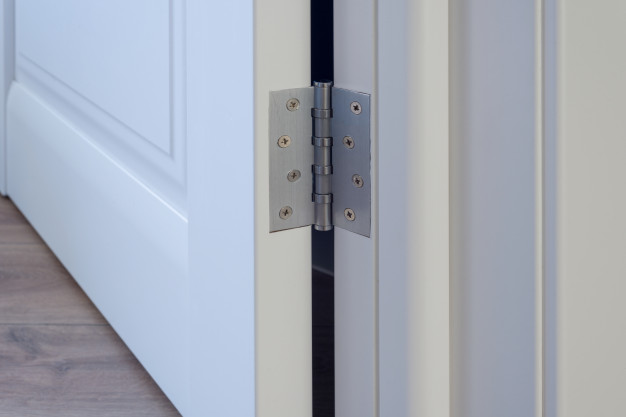
The common household problem that we come across is the loose hinges of the doors around the house, which usually happens because of excessive use of the doors without proper maintenance or children hanging with the doorknobs. The screws hold the whole weight of the door, but over the time they come out of their place, especially as a result of being tightened again and again. As a result of it, the door tends to bind, stick, or scrape the floor…and of course, it causes that irritating sound that we all hate.
So if you have an interior door with loose hinges and want to find a DIY solution to the issue, you have come to the right place. Here, we’ll help you maintain the sound-less, smooth door. By using this easy-to-follow procedure, you can not only add a new skill to your repertoire but also save your hard-earned money that was destined to go to an expensive professional.
So, without further ado, let’s get started.
Causes
The question is what really causes all this disruption? If the hinge screws are loose for not a long time, you tighten them with a screwdriver and prevent any further damage. However, when hinge screws are loose and left unattended, the hinge plate's constant movement start to cause the screws to widen the holes of the screw. The holes gradually get so wide that the screws cannot stay tight. This result into the screws being stripped and they end up being useless!
What You Need To Do
If you notice that the door is still sagging after tightening the hinge screws, then it means that there is a problem of widened holes that must be patched. Repair one screw hole at a time to prevent you from removing/changing the entire door and to save you valuable time and energy. This is how you need to do it:
Tool You’ll Need
- 3-in (zinc plated) screw
- Carpenters glue
- Drill Machine
- Hammer
- Screwdriver
- Screws
- A smaller drill bit (to drill new holes after the existing holes have been patched)
Getting Started
All you have to do is replace the hinge screw of ¾ inch with a 3-inch hinge screw that easily goes through the points, hence becoming the anchor in the frame to give a tight grip.
The method for tightening loose door hinges is quite simple. First, you’ll need to find the loose screws and remove them. Then, you’ll need to dip the bare end of a wooden match in same carpenter’s glue and hammer it all the way in, pushing it as far as it goes. Break or even cut off the match flush with the hinge plate and remove the heads.
Step 1 – Before removing the screw and letting go of the door, you need to give it firm support by holding or putting a heavy object in front so that it does not fall off.
Step 2 – Remove the screws carefully with the help of screw screwdriver or drill machine in reverse action.
Step 3 – In order to fill the extra gap in the hole, dip the bare end of a wooden match into the carpenters glue and push it into the hole with the help of a hammer (if required).
Step 4 – After filling the extra gap in the holes with the wooden matches or dowels, take the screw and the driver of the required shape and size. Start spinning the screws into the holes with pressure so that the screws fit in properly, hence giving the door a good grip.
Step 5 – Don’t rush anything and let the glue dry appropriately as it helps ensure the screws don’t slip because of the wet glue and fit in the right position. Use a damp washcloth to clean the gluey mess around the holes. However, make sure that you do not shove the wooden matches or dowels in too far.
Step 6 – Follow the same steps mentioned above with the next screw-hole to fill the extra gaps and fit the screw in it.
Step 7 – Cross check that all screws are tightly fit and are settled in their holes before you remove the support.
Step 8 – At the end, coat the oil on the hinges to enhance the smoothness of the door, but there is no need to overdo it. Let the oil soak into the wood for a few hours and then reinstall the screws.
For Your Information
- Instead of matching, you can use glue-coated wooden golf tees to plug a stripped screw hole golf tees that are tapered to fit easily in the screw hole.
- If your door only has 3 holes, it would be recommended to add only one 3 inch screws that should be drilled carefully in a newly created space rather than the old one
- Consider in your power drill against a driver bit just to make sure you don't use too much pressure and strip back the screws.
- For dry wood, it is best to use self-drilling screws (which have a drill bit on the end rather than a point). Screws with points on them are intended for use in new wood (called greenwood) which still contains liquid. Be delicate and use self-drilling screws of 1.5 inches or 2 inches and if you need to, you can remove the screws in the future.
Bottom Line
The cycle of a loose hinge often begins with only one loose screw. Many people do not pay much attention to a sticking door until it becomes too big a problem to ignore. People should pay attention to even slightest of signs to avoid the problem altogether. If the replacement of the screws by the above-mentioned method does not work and problem strikes up again, there is another solution; you can plane the door with a belt sander. If you are unable to do it, then we would highly recommend you to search for a professional person for the job.
We also recommend:
- How To Fix A Door That Won't Stay Open Or Closed
- How to fix an interior door that won't close
- How to fix a sagging interior door
- How to fix a tight interior door
- How To Repair A Damaged Hollow Core Door
- Some Tips and Solutions on How to Avoid Door Warping
- How to fix or replace a door frame
- How to fix a squeaky door
- Turn a plain door to panel door
- The Most Common Interior Door Problems and How to Fix Them

